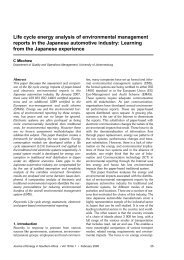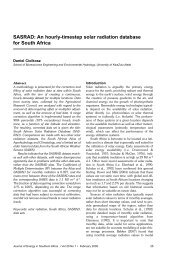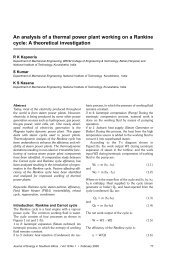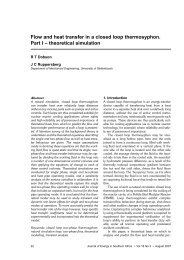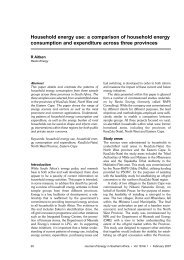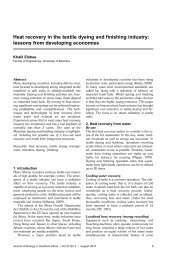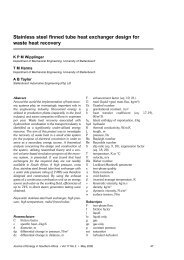Solar electrification by the concession approach in rural Limpopo ...
Solar electrification by the concession approach in rural Limpopo ...
Solar electrification by the concession approach in rural Limpopo ...
Create successful ePaper yourself
Turn your PDF publications into a flip-book with our unique Google optimized e-Paper software.
<strong>Solar</strong> <strong>electrification</strong> <strong>by</strong> <strong>the</strong> <strong>concession</strong> <strong>approach</strong> <strong>in</strong> <strong>rural</strong> <strong>Limpopo</strong> prov<strong>in</strong>ce 72.6 Employment status of household headsTable 2.9: Employment status of household head accord<strong>in</strong>g to sub-samplesSHS usersGrid usersNon-electrifiedhouseholdsEmployed 58% 49% 40%Unemployed 15% 9% 33%Self-employed 8% 20% 2%Housewife 19% - 3%Pensioner - 29% 21%Disability pension - - 2%Hav<strong>in</strong>g already noted <strong>the</strong> prevalence of formal employment among SHS-users, and own bus<strong>in</strong>essesamong grid-users from look<strong>in</strong>g at sources of <strong>in</strong>come, <strong>the</strong> trends shown <strong>in</strong> employment status ofhousehold heads are to be expected. The high unemployment rate (more than double that of SHSusersand more than triple that of grid-users) among non-electrified household heads partly expla<strong>in</strong>s<strong>the</strong> comparatively low <strong>in</strong>come levels found <strong>in</strong> this sub-sample. It has already been noted that SHSuserstend to have <strong>the</strong> youngest household heads, which partly expla<strong>in</strong>s <strong>the</strong> absence of pensioners forthis sub-sample.2.7 Migration: Household members liv<strong>in</strong>g away from homeThis section explores <strong>the</strong> issues around <strong>the</strong> movement of household members to o<strong>the</strong>r areas and <strong>the</strong>irimpacts on household <strong>in</strong>come. It is readily apparent that roughly half of <strong>the</strong> households <strong>in</strong> eachcategory have no members liv<strong>in</strong>g elsewhere. There is strik<strong>in</strong>g similarity across sub-samples <strong>in</strong> thischaracteristic, which may have less to do with mode of <strong>electrification</strong> than with o<strong>the</strong>r local factors.SHS-users have <strong>the</strong> highest percentage of absent household heads, which may be expla<strong>in</strong>ed <strong>by</strong> <strong>the</strong>fact that this sub-sample has <strong>the</strong> highest percentage of formally employed household heads, who arepredom<strong>in</strong>antly male. Formal jobs are generally available <strong>in</strong> towns. SHS-users were found to havepractically no contribution to household <strong>in</strong>come from non-members, and <strong>the</strong>y were alsopredom<strong>in</strong>antly not support<strong>in</strong>g absent members. Grid-users, on <strong>the</strong> o<strong>the</strong>r hand, have only half <strong>the</strong>percentage of absent of household heads, which may be partly due to <strong>the</strong> sub-sample hav<strong>in</strong>g <strong>by</strong> far<strong>the</strong> highest percentage of self-employed household heads who are most likely to work locally. Thesub-sample has, <strong>by</strong> a wide marg<strong>in</strong>, <strong>the</strong> highest <strong>in</strong>cidence of <strong>in</strong>com<strong>in</strong>g remittances from outside <strong>the</strong>household. The reason for this is not obvious. Like <strong>the</strong> SHS-users, <strong>the</strong>re is virtually no reportedf<strong>in</strong>ancial support of absent household members.Non-electrified households stand out <strong>in</strong> hav<strong>in</strong>g <strong>the</strong> highest proportion of households support<strong>in</strong>gabsent members, yet this is <strong>the</strong> lowest <strong>in</strong>come sub-sample. They have virtually no <strong>in</strong>com<strong>in</strong>gremittances, but have already been shown to have <strong>the</strong> widest range of <strong>in</strong>come sources. The identitiesof <strong>the</strong> absent beneficiaries were not explored <strong>in</strong> <strong>the</strong> survey questionnaire.Table 2.10: Absent household members and related issuesSHS-users Grid-users Non-electrifiedhouseholdsHousehold head absent 33% 18% 25%% of households with no members liv<strong>in</strong>g elsewhere 51% 53% 54%Someone else 3 contribut<strong>in</strong>g to households 2% 27% 4%Support<strong>in</strong>g absent members (child, parent) 3% 4% 11%3 The survey did not explore <strong>the</strong> identity of <strong>the</strong> o<strong>the</strong>r persons contribut<strong>in</strong>g to <strong>the</strong> householdENERGY RESEARCH CENTRE





